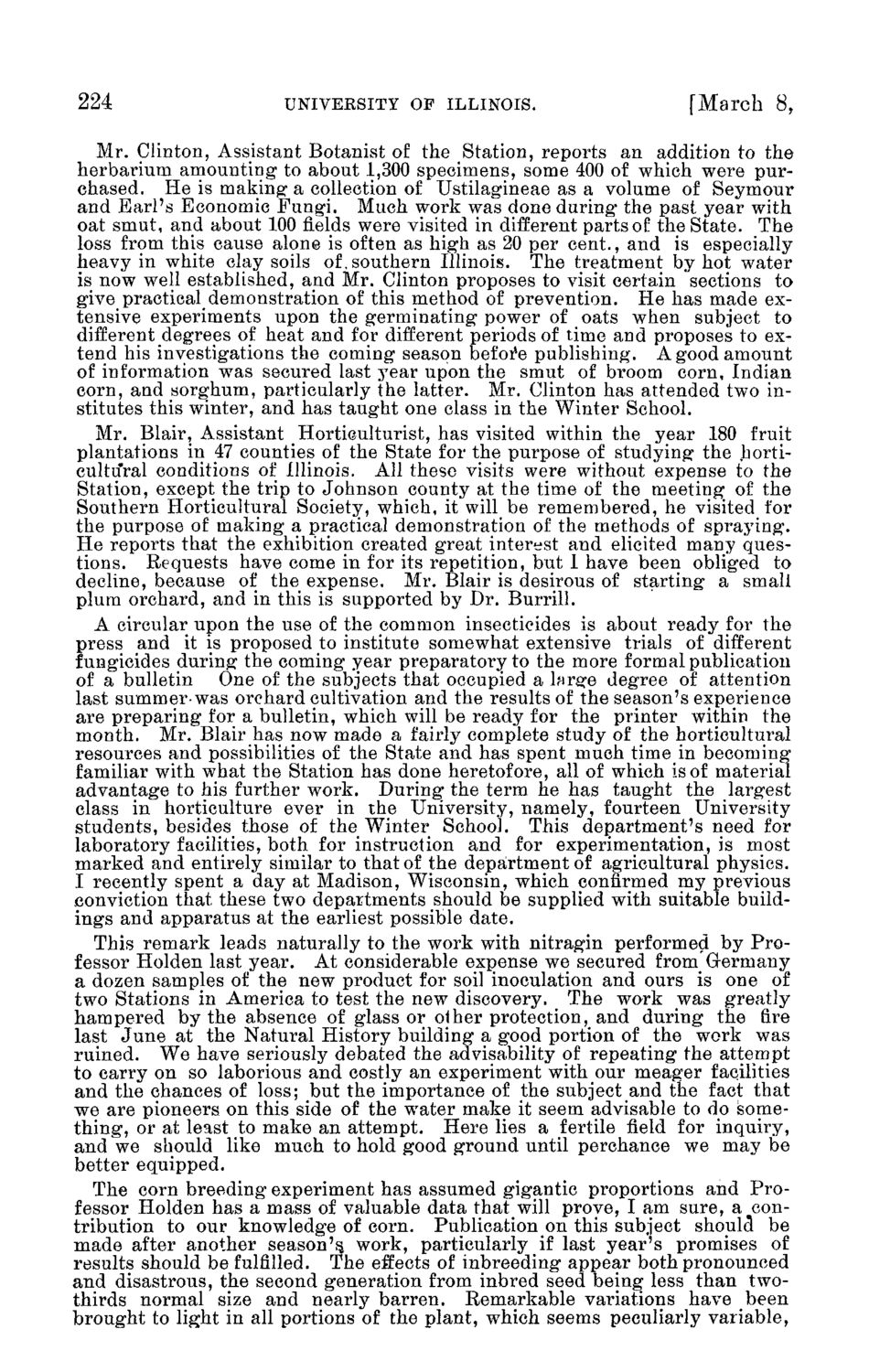| |
| |
Caption: Board of Trustees Minutes - 1898
This is a reduced-resolution page image for fast online browsing.

EXTRACTED TEXT FROM PAGE:
224 UNIVERSITY O F I L L I N O I S . [March 8, Mr. Clinton, Assistant Botanist of the Station, reports an addition to the herbarium amounting to about 1,300 specimens, some 400 of which were purchased. He is making a collection of Ustilagineae as a volume of Seymour and Earl's Economic Fungi. Much work was done during the past year with oat smut, and about 100 fields were visited in different parts of the State. The loss from this cause alone is often as high as 20 per cent., and is especially heavy in white clay soils of. southern Illinois. The treatment by hot water is now well established, and Mr. Clinton proposes to visit certain sections to give practical demonstration of this method of prevention. He has made extensive experiments upon the germinating power of oats when subject to different degrees of heat and for different periods of time and proposes to extend his investigations the coming season before publishing. A good amount of information was secured last year upon the smut of broom corn, Indian corn, and sorghum, particularly the latter. Mr. Clinton has attended two institutes this winter, and has taught one class in the Winter School. Mr. Blair, Assistant Horticulturist, has visited within the year 180 fruit plantations in 47 counties of the State for the purpose of studying the .horticultural conditions of Illinois. All these visits were without expense to the Station, except the trip to Johnson county at the time of the meeting of the Southern Horticultural Society, which, it will be remembered, he visited for the purpose of making a practical demonstration of the methods of spraying. He reports that the exhibition created great interest and elicited many questions. Requests have come in for its repetition, but 1 have been obliged to decline, because of the expense. Mr. Blair is desirous of starting a small plum orchard, and in this is supported by Dr. Burrill. A circular upon the use of the common insecticides is about ready for the press and it is proposed to institute somewhat extensive trials of different fungicides during the coming year preparatory to the more formal publication of a bulletin One of the subjects that occupied a l^rge degree of attention last summer-was orchard cultivation and the results of the season's experience are preparing for a bulletin, which will be ready for the printer within the month. Mr. Blair has now made a fairly complete study of the horticultural resources and possibilities of the State and has spent much time in becoming familiar with what the Station has done heretofore, all of which is of material advantage to his further work. During the term he has taught the largest class in horticulture ever in the University, namely, fourteen University students, besides those of the Winter School. This department's need for laboratory facilities, both for instruction and for experimentation, is most marked and entirely similar to that of the department of agricultural physics. I recently spent a day at Madison, Wisconsin, which confirmed my previous conviction that these two departments should be supplied with suitable buildings and apparatus at the earliest possible date. This remark leads naturally to the work with nitragin performed by Professor Holden last year. At considerable expense we secured from'Germany a dozen samples of the new product for soil inoculation and ours is one of two Stations in America to test the new discovery. The work was greatly hampered by the absence of glass or other protection, and during the fire last June at the Natural History building a good portion of the work was ruined. We have seriously debated the advisability of repeating the attempt to carry on so laborious and costly an experiment with our meager facilities and the chances of loss; but the importance of the subject and the fact that we are pioneers on this side of the water make it seem advisable to do something, or at least to make an attempt. Here lies a fertile field for inquiry, and we should like much to hold good ground until perchance we may be better equipped. The corn breeding experiment has assumed gigantic proportions and Professor Holden has a mass of valuable data that will prove, I am sure, a 1contribution to our knowledge of corn. Publication on this subject should be made after another season's, work, particularly if last year's promises of results should be fulfilled. The effects of inbreeding appear both pronounced and disastrous, the second generation from inbred seed being less than twothirds normal size and nearly barren. Remarkable variations have been brought to light in all portions of the plant, which seems peculiarly variable,
| |